3 MIN READ
Corn Stalk Rots & Lodging Issues
November 10, 2023
Physiological Stalk Lodging
Physiological stalk lodging is usually the result of an interaction between weather, fertility, compaction, leaf disease, plant population, planting date, and kernel fill. Ultimately, anything that reduces photosynthesis and the production of carbohydrates (sugars) may negatively impact stalk integrity. The result can be cannibalization of the stalk as grain fill takes priority over other plant functions. Physiological lodging can be just as severe as pathological stalk lodging; however, since pathogens may not be the cause, the interior plant pith may appear white in color when physiologically lodged (Figure 1). Alternatively, Plants suffering from physiological stalk weakness become increasingly susceptible to secondary problems, such as stalk rots. Fungi may also colonize these vulnerable tissues, giving the appearance of stalk rot even though the primary cause is physiological.
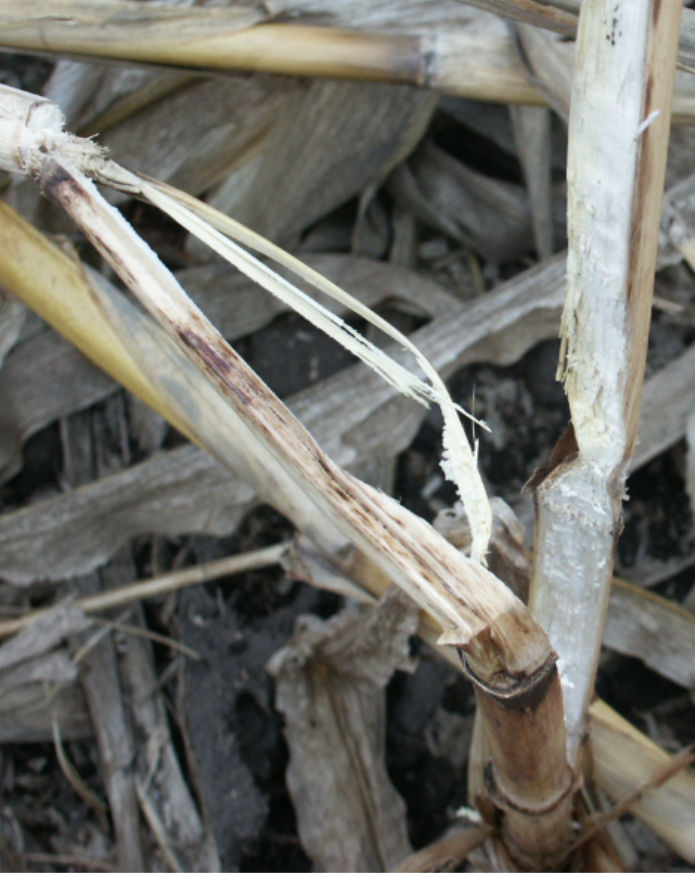
Causes of Physiological Stalk Lodging
- Inadequate root growth, possibly due to wet and cool weather at planting, compaction, insect feeding, or injury from fertilizers or herbicides. Without a viable root system, a dry environment during grain fill can cause the plant to cannibalize nutrients and water from the stalk to nourish developing kernels.
- Nutrient deficiency that restricts photosynthesis can lead to lodging issues. Photosynthesis is required to produce sugars which, in turn, are used to make proteins and other substances to support plant growth. A severe nitrogen (N) or potassium (K) deficiency can result in reduced photosynthesis and result in stalk cannibalization.
- Leaf diseases such as gray leaf spot, tar spot, and northern corn leaf blight can destroy green leaf tissue. When stalks deteriorate due to either cannibalization or stalk rots, they become increasingly subject to lodging. Corn products vary in resistance to individual diseases and in their inherent stalk strength.
- High plant populations can affect standability if the in-season management and growing environment are not supportive of the population.
- Drought conditions or prolonged periods of cloudy weather during grain fill can force the plant into stalk cannibalization to support grain fill. Rain and wind can cause the plants to lodge prematurely, possibly before black layer formation.
- Planting date can also be an indirect factor, as kernel row number is determined in the early growth stages. Favorable weather during that time can increase the number of potential kernels, while poor weather such as drought during grain fill can result in stalk cannibalization to support grain fill, thus weakening the stalks and increasing the likelihood of physiological stalk lodging.
Pathological Stalk Lodging
Pathological stalk lodging can be caused by the presence of one or more stalk rot diseases. Stalk rots are favored by good early season growing conditions followed by stress after pollination. Stresses can include drought, nutrient deficiencies, foliar diseases, hail damage, high heat, and prolonged cool, cloudy weather. Common stalk rot diseases associated with lodging include Anthracnose, Diplodia, Fusarium, Gibberella, and Charcoal stalk rots. While not a rot in the technical sense, Physoderma stalk breakage can also result in lodging. For more information on stalk rot identification and management see Late Season Corn Diseases Identification.
- Anthracnose stalk rot symptoms are usually most apparent just prior to plant maturity. The disease is identifiable by the shiny black discoloration of the outer stalk rind that develops in blotches or streaks, especially on the lower internodes (Figure 2). Internal pith may become black and soft, and the symptoms may extend to several internodes. Conditions favoring Anthracnose stalk rot include infected surface residue, insect injury, and environmental stress. Resistance to Anthracnose stalk rot is available in specific corn products.
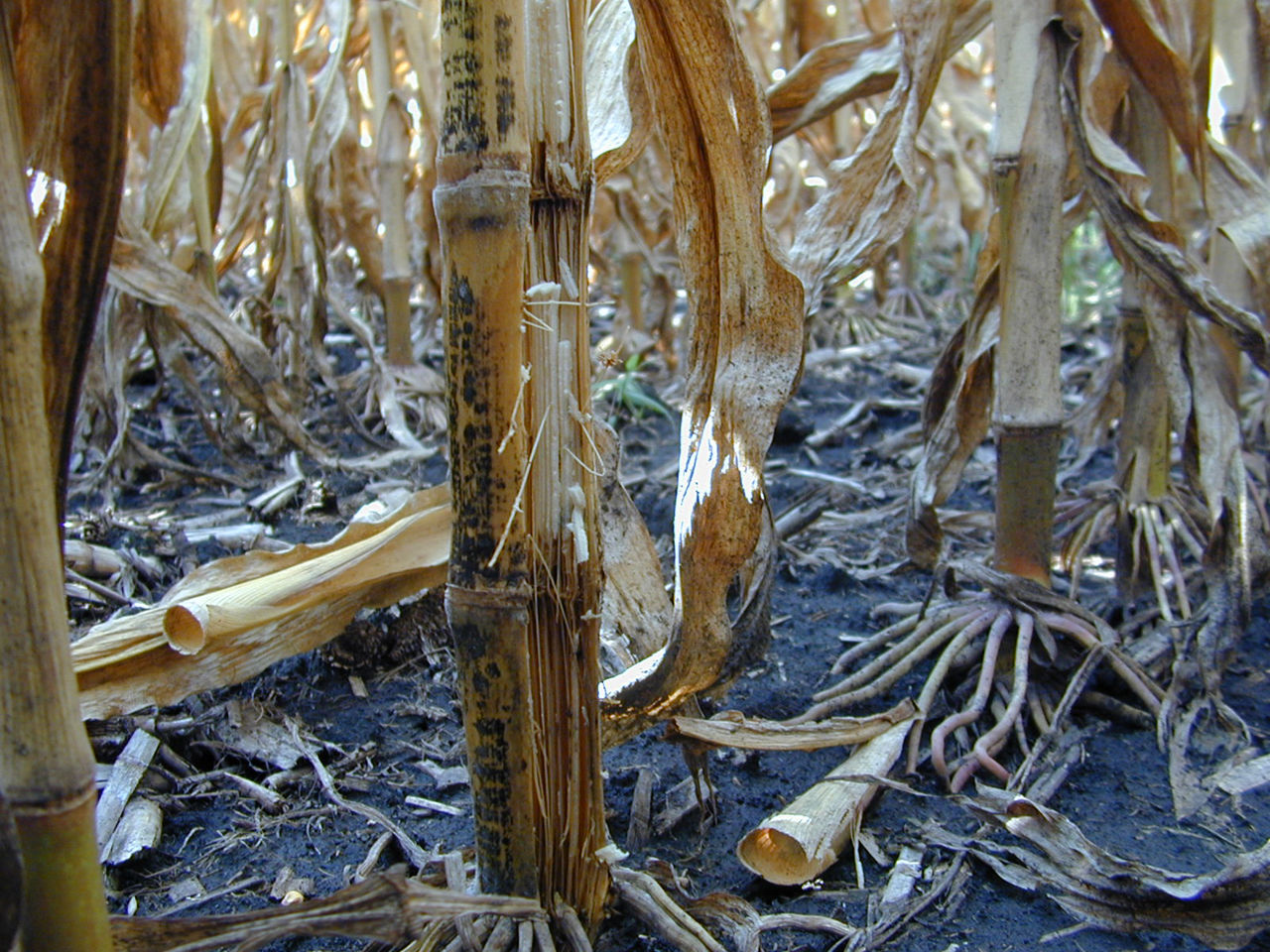
- Diplodia stalk rot symptoms are generally not noticed until several weeks after silking. Plants may begin to die prematurely when they take on a grayish-green cast, like frost injury. Lower stalk internodes become brown- to straw-colored, spongy, dry, and easily crushable (Figure 3). Pith tissues disintegrate, leaving vascular strands intact. Tiny, dark fungal structures (pycnidia) form just under the stalk surface and cannot be scraped off. White fungal mycelium may appear on the stalk surface. Diplodia stalk rot development is favored by dry conditions early in the season followed by warm conditions (80 to 87 °F, 27 to 30 °C) and wet after silking. Plants can be predisposed to the disease by contracting leaf diseases, suffering hail damage, insect feeding, high nitrogen use, low potassium, and growing in high population densities. The causal fungus overwinters on plant residue; therefore, reduced tillage and continuous corn fields can have an increase in inoculum levels available to cause infection. Infection can occur through seedling root, mesocotyl, or crown tissues.
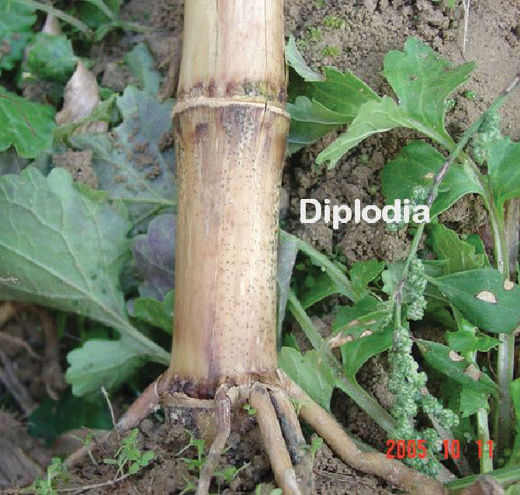
- Fusarium stalk rot is difficult to diagnose, but it is usually identifiable by a whitish-pink to salmon discoloration in the stalk pith. The pith disintegrates much like other stalk rots; however, the disintegration may be more notable at the nodes. Symptoms are usually more severe when stress occurs during the growing season. The pathogen usually enters the plant through the roots, mesocotyl, or crown tissues, although hail or insect damage are also avenues of infection.Fusarium usually begins as a crown rot that progresses into the stalks.
- Gibberella stalk rot is distinguished by the pink to reddish coloration of disintegrated pith tissue and root crowns that are often discolored and severely rotted (Figure 4). In contrast to Fusarium stalk rot, Gibberella stalk rot has small, round, black specks called perithecia near the nodes that can be easily scraped off. The fungus survives on infested plant residue and is the same fungus that is responsible for head scab of wheat and barley. It is considered a debris-borne disease that can occur in most fields if conditions are favorable. Infection generally occurs through the roots, mesocotyl, and crown tissues. The disease appears to be more severe when crop stress occurs after tasseling.
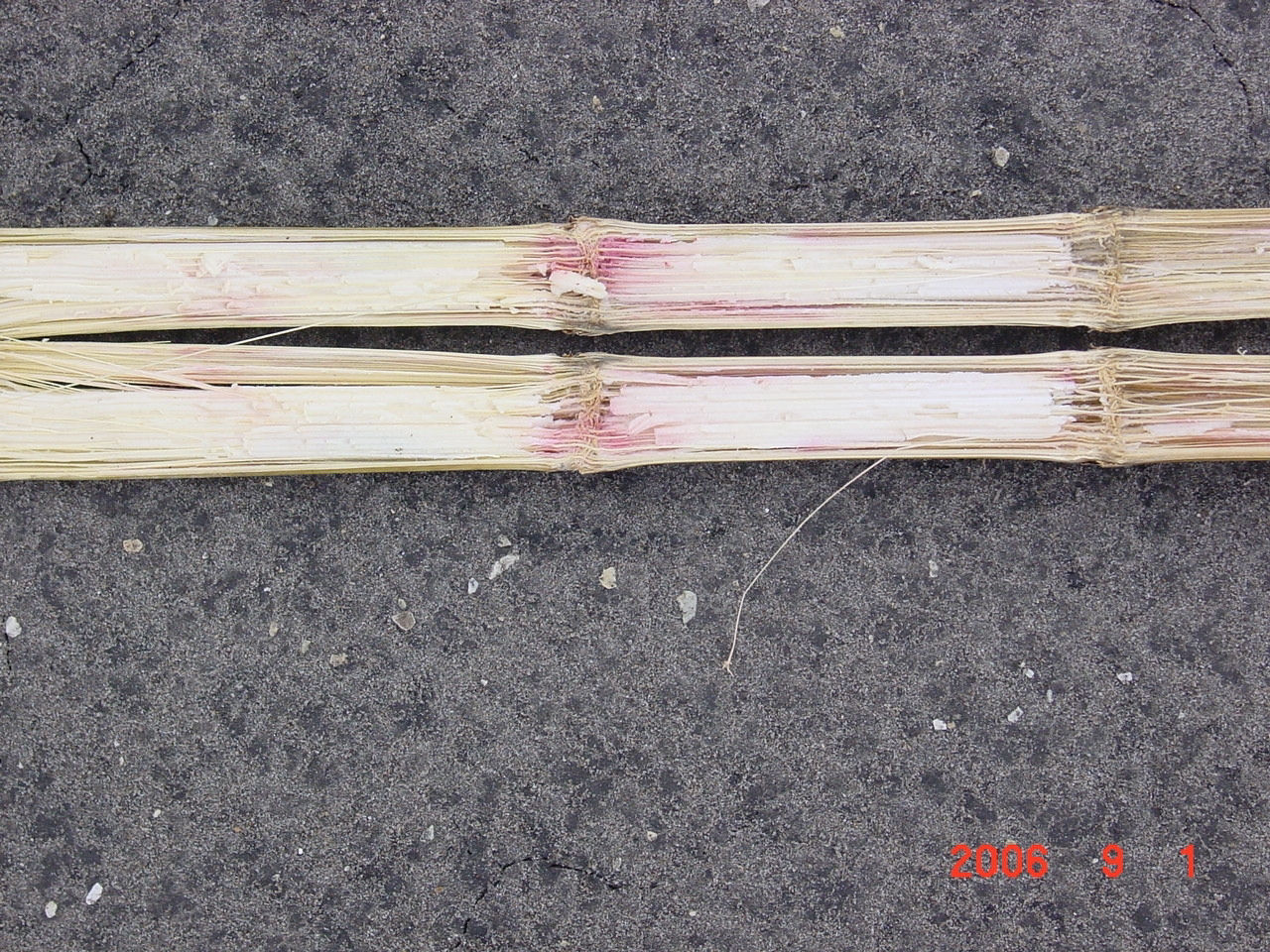
- Charcoal stalk rot can appear when drought and high soil temperatures occur. The interior stalk pith becomes discolored with black micro-sclerotia, which have the appearance of charcoal that has been rubbed on the pith. The pith disintegrates, leaving behind the vascular bundles. The fungus infects through the roots, mesocotyl, and crown early in the season; however, symptoms usually do not appear until near maturity.
- Physoderma stalk breakage can result when infection occurs in nodes 6 and 7. Infected nodes are rotted and snap easily when gently pushed (Figure 5).1 The brown bands associated with Physoderma brown spot are often not visible on the leaves of plants affected with stalk rot. Infected plants often look very healthy and have excellent yield potential.1
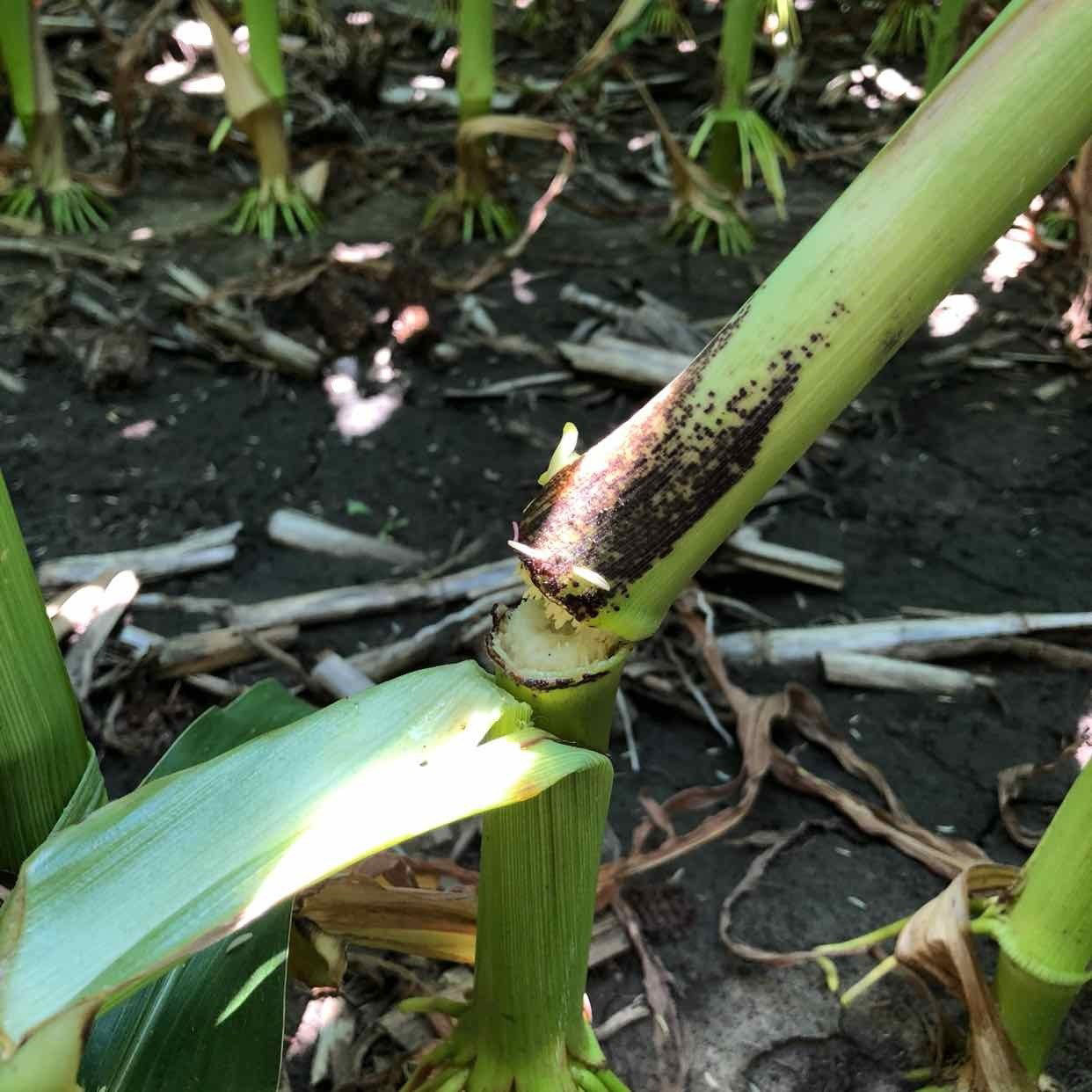
Scouting for Lodging Potential
Scouting fields for potential lodging should begin in late summer. Each corn product within a field and fields with different management practices should be scouted separately. To determine stalk strength, a zigzag pattern should be taken through products or fields to evaluate 100 plants by pinching lower nodes or pushing stalks to a 45° angle. If more than 10 to 15% of the stalks can be crushed or broken, substantial lodging is possible. An early harvest should be considered after black layer formation, regardless of kernel moisture content, if there is a potential for significant lodging.
Harvesting Lodged Corn
Harvesting corn early can increase drying costs, but the expense could result in an increase in harvested bushels and dollars. Fields should generally be harvested as soon as they are ready in order to reduce the chance of lodging,2 though every situation is unique and will call for different management tactics.
To evaluate possible changes that may improve combine harvest, it is important to measure losses in the field behind the combine. Ears that stay below the combine head and are not gathered in are the most common source of machine loss in lodged corn. Each 3/4-lb ear found in a hundredth of an acre equals a loss of one bushel per acre (0.6 quintal/hectare). If losses are excessive, check a similar unharvested area ahead of the combine for ears already lying on the ground and not attached to stalks. These would be preharvest losses that would be unlikely to be picked up by the head regardless of adjustment.
Suggestions
- Accept that harvest will not be routine in these areas and patience will pay off. First, answer the following questions.
- How many acres are lodged?
- How severe is the lodging?
- What percentage of the total acres that must be harvested does this represent?
- Will the available labor and equipment be adequate to handle the situation?
- Adjust the combine.
- Slowing combine travel speed may reduce the amount of missed ears.
- Harvest in the opposite direction of the lodged corn (e.g., harvest toward the west in fields of east-leaning cornstalks).
- Make sure ear savers on the corn head are in good condition.
- Gathering snouts should be kept low to pick up downed ears. Gathering chains may need to be more aggressive.2
- Place stripper bars closer together if ear butt-shelling occurs on the stalk rolls.
- Consider procuring a corn head reel or other attachments such as crop dividers or lifters. A reel may allow faster combine travel speed even if it does not decrease losses, allowing for a faster harvest with similar losses.2
- Crop dividers mounted on each side of the head help to lift ears into the head that might otherwise escape.
- Take your time and have a safe and efficient harvest.
Sources
1Robertson, A. 2015. Physoderma brown spot and stalk rot. Iowa State University Extension and Outreach. ICM News. https://crops.extension.iastate.edu/cropnews/2015/07/physoderma-brown-spot-and-stalk-rot
2Hanna, M. 2002. Harvesting lodged corn. Iowa State University. https://crops.extension.iastate.edu/encyclopedia/harvesting-lodged-corn
Additional Resources
Nielsen, B. 2002. Scout stressed fields for root & stalk rots. Purdue University. https://www.agry.purdue.edu/ext/corn/news/articles.02/Stalk_Rots-0814.html
Anderson, M. and Robertson, A. 2020. Scout corn fields for stalk rot. Iowa State University. https://crops.extension.iastate.edu/blog/alison-robertson-meaghan-anderson/scout-corn-fields-stalk-rot
Nielsen, B. and Coville, D. 1988. Stalk lodging in corn: Guidelines for preventive management. Purdue University. https://www.extension.purdue.edu/extmedia/ay/ay-262.html
1211_145715